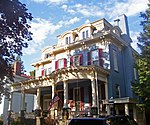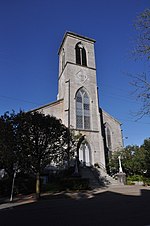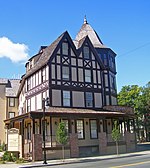Boice House
Greek Revival houses in New York (state)Houses completed in 1850Houses in Ulster County, New YorkHouses on the National Register of Historic Places in New York (state)Kingston, New York ... and 2 more
National Register of Historic Places in Ulster County, New YorkSecond Empire architecture in New York (state)

The Boice House is located on Fair Street in Kingston, New York, United States. It was first built around 1850 in the Greek Revival architectural style. Twenty years later, it was bought by Hewett Boice, a local quarry operator. He had the house refurbished in the then-popular Second Empire style. It was listed on the National Register of Historic Places in 2001.
Excerpt from the Wikipedia article Boice House (License: CC BY-SA 3.0, Authors, Images).Boice House
Wall Street,
Geographical coordinates (GPS) Address Nearby Places Show on map
Geographical coordinates (GPS)
| Latitude | Longitude |
|---|---|
| N 41.927777777778 ° | E -74.016111111111 ° |
Address
Wall Street 117
12401
New York, United States
Open on Google Maps









